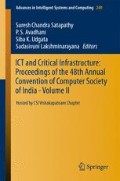Abstract
Microarray is a technology which allows biologists to potentially monitor the activity of all the genes of an organism. Microarrays, widely recognized as the next revolution in molecular biology, enables scientists to analyze genes, proteins and other biological molecules on a genomic scale. Image processing is the first step in knowledge discovery from the microarray. The process of extracting features consists of three stages: gridding, segmentation and quantification. Gridding is to assign each spot with individual coordinates. This paper presents a fully automatic grid configuration algorithm for detecting the microarray image spots as input, and makes no assumptions about the size of the spots, and number of rows and columns in the grid. The approach is based on the detection of an optimum sub image. This method is capable of processing the image automatically and does not demand any input parameters. Experimental result shows that this method is highly efficient method of gridding that uses intensity projection profile.
Access this chapter
Tax calculation will be finalised at checkout
Purchases are for personal use only
Preview
Unable to display preview. Download preview PDF.
References
Wu, S., Yan, H.: Microarray image processing based on clustering and morphological analysis. In: Proceedings of the First Asia-Pacific Bioinformatics Conference on sBioinformatics 2003, vol. 19, pp. 111–118 (2003)
Draghici, S.: Data Analysis Tools for DNA Microarrays. Chapman and Hall/CRC (2003)
M. Schena Microarray Analysis. Wiley-Liss (2002)
DeRisi, J.L., Iyer, V.R., Brown, P.O.: Exploring the metaboblic and genetic control of gene expression on a genomic scale. Science 278, 680–686 (1997)
Schena, M., Shalom, D., Davis, R., Brown, P.: Quantitative monitoring of gene expression patterns with a complementary DNA microarray. Science 270, 467–470 (1995), Stekel, D.: Microarray bioinformatics. Cambridge University Press, Cambridge (2003), Bowtell, D., Sambrook, J.: DNA microarrays: A molecular cloning manual. Cold Spring Harbor Laboratory Press (2003)
Rueda, L., Qin, L.: An Improved Clustering-Based Approach for DNA Microarray Image Segmentation. In: Campilho, A.C., Kamel, M.S. (eds.) ICIAR 2004. LNCS, vol. 3212, pp. 17–24. Springer, Heidelberg (2004)
Ceccarelli, M., Petrosino, A.: The Orientation Matching Transform Approach to Circular Object Detection. In: Proceedings of IEEE International Conference on Image Processing, pp. 712–715 (2001)
Anandhavalli, M., Mishra, C., Ghose, M.K.: Analysis of Microarray Image Spot Intensity: A Comparative Study. International Journal of Computer Theory and Engineering 1(5), 1793–8201 (2009)
Larese, M.G., Gomez, J.C.: Automatic Spot Addressing in cDNA Microarray Images. JCS&T 8(2) (July 2008)
Deepa, J., Thomas, T.: Automatic Gridding of DNA Microarray Images Using Optimum Sub-image. International Journal of Recent Trends in Engineering 1(4) (May 2009)
Deepa, J., Thomas, T.: A New Gridding Technique for High Density Microarray Images Using Intensity Projection Profile of Best Sub Image. Computer Engineering Intelligent Systems 4(1) (2013) ISSN 2222-1719
Rueda, L., Rezaeian, I.: A Fully automatic gridding method for cDNA microarray images. BMC Bioinformatics (April 21, 2011)
Labib, F.E.-Z., Fouad, I., Mabrouk, M., Sharawy, A.: An Efficient Fully Automated Method for Gridding Microarray Images. American Journal of Biomedical Engineering 2(3), 115–119 (2012)
Sorin, D.: Data analysis tool for DNA Microarrays. Mathematical biology and medicine series. Chapman&Hall/CRC, London (2003)
Stekel, D.: MicroarrayBioinformatics. Cambridge University Press, NewYork (2003)
Lonardi, S., Luo, Y.: Gridding of microarray images. In: Proceedings of IEEE Computational Systems Bioinformatics Conferences, CSB 2004 (2004), doi:0-7695-2194-0/04
Author information
Authors and Affiliations
Editor information
Editors and Affiliations
Rights and permissions
Copyright information
© 2014 Springer International Publishing Switzerland
About this paper
Cite this paper
Srimani, P.K., Mahesh, S. (2014). An Effective Automated Method for the Detection of Grids in DNA Microarray. In: Satapathy, S., Avadhani, P., Udgata, S., Lakshminarayana, S. (eds) ICT and Critical Infrastructure: Proceedings of the 48th Annual Convention of Computer Society of India- Vol II. Advances in Intelligent Systems and Computing, vol 249. Springer, Cham. https://doi.org/10.1007/978-3-319-03095-1_47
Download citation
DOI: https://doi.org/10.1007/978-3-319-03095-1_47
Publisher Name: Springer, Cham
Print ISBN: 978-3-319-03094-4
Online ISBN: 978-3-319-03095-1
eBook Packages: EngineeringEngineering (R0)

